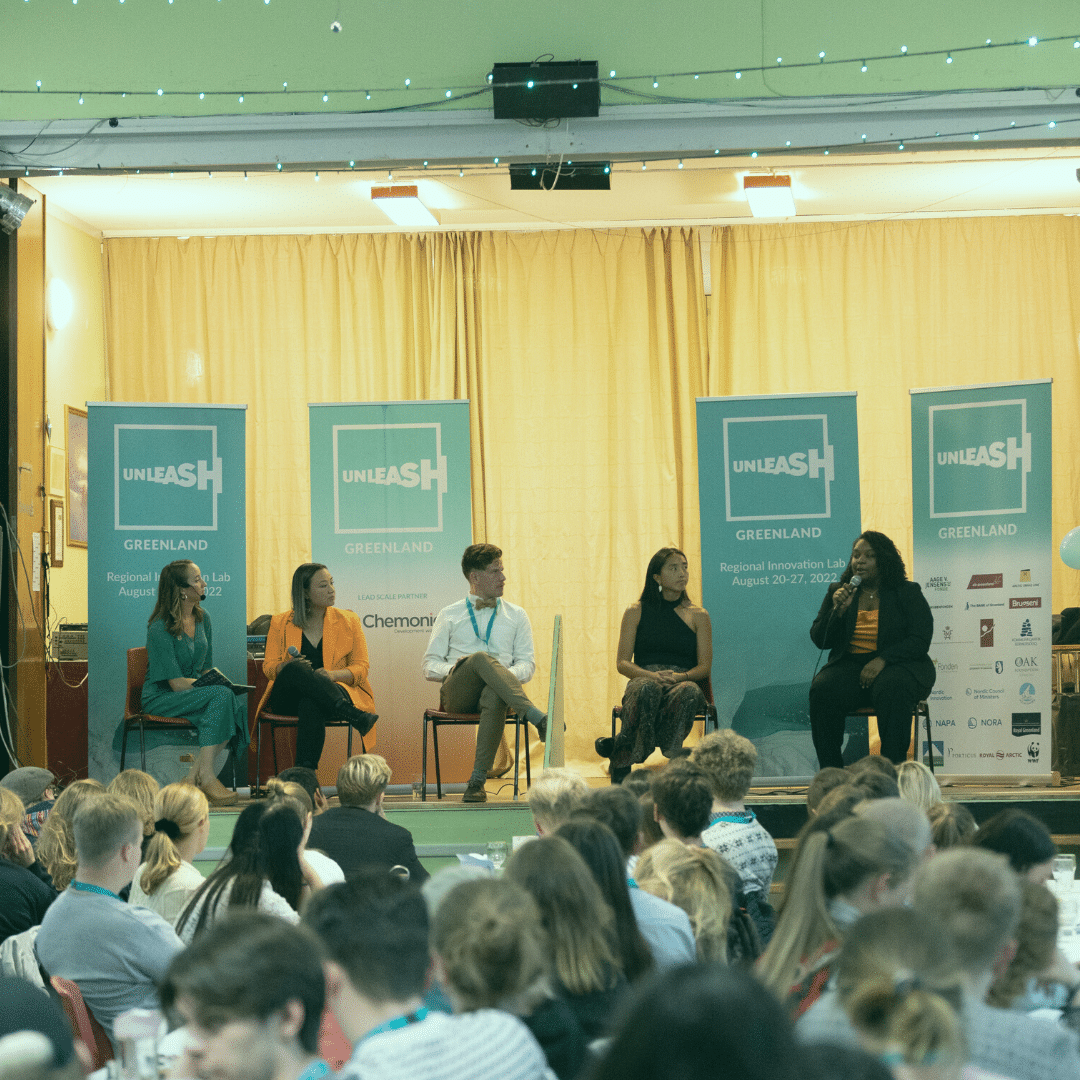
You are Enough: The Power of Collective Action
Panelists speak at the UNLEASH Greenland youth and climate action panel. Left to right: Hailey Dougherty (Chemonics Environment and Natural Resources Specialist), Aka Niviana (Inuk Poet and Climate Changemaker), William Gagnon (Yellowknife NW Territories, Climate Changemaker), Anna Pettee (Unbounded Associates Program Manager and Emerging Climate Educator), and Ashley Hill (Chemonics Education and Youth Acting Specialist).
What is our future if we do not work together towards change? Ayisha Siddiqa may have said it best, “If the future leaves without us, the silence that will follow will be an unspeakable nothing. What if we convince her to stay? How rare and beautiful it is that we exist. What if we stun existence one more time? … Love is still the only revenge. It grows each time the earth is set on fire. But for what it’s worth, I’d do this again. Gamble on humanity one hundred times over.” We are still capable of creating and sustaining a world that we desire to live in. May we find a way to bridge the gaps, embrace our differences, and realize that diversity is the strength of mankind.
On August 21st, UNLEASH hosted a panel focused on youth and climate action at its first Regional Innovation Lab in Nuuk, Greenland. Two hundred young people from Arctic and Nordic countries gathered to listen to youth panelists who brought in perspectives as climate activists, educators, and youth engagement experts. Before hitting the stage, Siila Watt-Cloutier, Canadian Inuit climate advocate and Nobel Peace Prize nominee, gave us a simple piece of public speaking advice that resonated throughout the duration of the Lab: be authentic and speak from your experience. We reflected on the realities of climate change where we live in Greenland, Canada, and the east and west coasts of the United States, all of which look drastically different with varying implications.
As a South Carolina native, I recall sharing the possibility of loss of prominent groups, like the Gullah Geechee Nation, and fears of climate gentrification as people migrate inland due to rising sea levels. As our discussion continued, we covered a range of topics, from coping with ecoanxiety, to enabling factors that support youth in accessing green jobs, understanding the intersection of climate action and social justice, and more widely incorporating indigenous peoples and knowledge into climate action. Climate changemaker William Gagnon detailed his act of bravery in resigning from his governmental position due to a lack of climate ambition. Anna Pettee, emerging climate educator, shared findings from her research on Centering Youth in Green Workforce Development, while I provided examples of youth-led solutions from Chemonics-implemented projects. Aka Niviana, Inuk poet and climate changemaker, discussed the role of creativity in climate action. In addition to sharing our professional experiences, we shared personal stories of courage, leadership, and historical impacts. And one of the most compelling sentiments that divulged from our conversation was the power of collective action.
There is tremendous value in collective action that young people have already begun to recognize. In Chemonics’ analysis of global youth-led climate initiatives, we found that grassroots initiatives, networks, and organizations that are initiated by young people, are more likely to have mass mobilization – or “people power” – to help carry out their activities. This means that youth-led movements are more likely to be supported by and connected to the vast and growing young people on the ground. Moreover, as exemplified in the United Nations’ recently-released Youth Declaration on Transforming Education, collective responsibility, duty, and opportunity can push towards systems of accessibility and inclusion. Collective action is unifying. It is an opportunity to create solidarity. It erases the perception of who is “qualified” to engage in combating a certain issue, and instead, recognizes that everyone has skills that are relevant and can be contributed in a meaningful way.
That is the very example that UNLEASH sets as well. UNLEASH’s innovation labs are collective action at work. At the start of UNLEASH Greenland, the participants (also known as “Talents”) were split into groups to generate solutions to the Sustainable Development Goals. Teams were composed of people from differing countries and professional backgrounds. As the teams navigated each step in the innovation process, it was necessary for every member to share their thoughts, experiences, and expertise. In doing so, they brought insights on community needs and solution feasibility. For example, a team that was working to further integrate the Greenlandic language into schools needed to understand existing challenges, effective learning techniques, and possible barriers to implementation. While some talents were able to share perspective on the context, others brought expertise on the subject matter at hand – each person was vital in ensuring that the solution would be appropriate and impactful. Further, by encouraging curiosity and providing talents with experts, facilitators, and other resources to assist them through the innovation process, UNLEASH created a safe space for expression and problem-solving, understanding that collaboration was essential to achieving their objective.
We already have the skills and knowledge it takes to transform the world. Though individual contributions are important, it is by working together that we can amplify our voices to effect real change that is inclusive. By listening and understanding, we can build genuine relationships to cultivate a more sustainable world. Above all, let us be authentic and use our experiences to reach others – that, alone, is already enough.
Should you be interested in connecting further, please reach out to the author, Ashley Hill, via LinkedIn.

